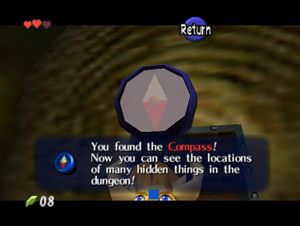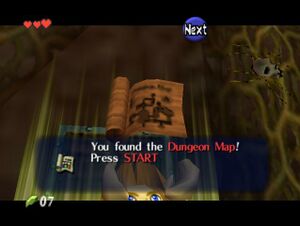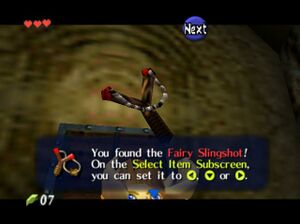Starting a new game or loading a game
Upon starting the game, the title screen appears which shows Link riding Epona in Hyrule Field and various scenes from the game. Pressing the ![]() button twice opens the main menu. In this menu, three save game slots are shown, along with the options to erase or copy a saved game. Furthermore, there's an options menu which allows you to change sound settings, the way the
button twice opens the main menu. In this menu, three save game slots are shown, along with the options to erase or copy a saved game. Furthermore, there's an options menu which allows you to change sound settings, the way the ![]() -targeting system works and some shades of black and grey to help set the brightness setting of your television. Highlighting a save game slot and pressing
-targeting system works and some shades of black and grey to help set the brightness setting of your television. Highlighting a save game slot and pressing ![]() opens that saved game. If no saved game exists, selecting a save game slot and choosing Yes starts a new game.
opens that saved game. If no saved game exists, selecting a save game slot and choosing Yes starts a new game.
Movement
The first thing you'll learn when you begin the game is how to run around using the control stick. Pressing the stick a little bit will make Link walk very slowly, which is good for navigating small walkways. Pressing it all the way to the edge will make Link run as fast as he can, which is necessary to Jump. If you walk off a ledge, Link will fall a bit and hopefully grab the ledge, otherwise he will fall straight down and may take damage based on the distance of the fall.
Jumping

In The Legend of Zelda: Ocarina of Time there is no jump button. Instead, Link will jump off of ledges if he approaches them while running. Be careful of your positioning, because it is easy to fall long distances.
Falling
If Link happens to fall off of a ledge, he will either hit the ground and take damage, or roll. To roll, simply hold the control stick in the direction he is moving (most often ![]() ).
).
HUD
- Action button
The action button shows you what ![]() will make Link do. For instance, if you have your sword equipped and you are standing still, the action button will show the symbol of a sword. Pressing the button will make Link attack. If you are running, the action button will change to "Roll", and pressing
will make Link do. For instance, if you have your sword equipped and you are standing still, the action button will show the symbol of a sword. Pressing the button will make Link attack. If you are running, the action button will change to "Roll", and pressing ![]() will make Link do a somersault.
will make Link do a somersault.
- Item assignments
At the top right of the screen are the three button assignments. These act as a way to keep track of what items are currently assigned to. By pressing a button with an assigned item, Link will pull out the item immediately and use it (draw an arrow and aim the bow, load and aim the slingshot, swipe with an empty jar, use a filled jar, etc.). You can change the button assignments by using the pause menu and navigating to the inventory section. Pressing a button while an item is selected will assign that item to the button pressed.
The usable buttons for these items vary by console:
- N64:
 ,
,  , and
, and  .
. - GameCube:
 (or
(or  ),
),  (or
(or  ), and
), and  (or
(or  ).
). - Wii classic controller:
 (or
(or  ),
),  (or
(or  or
or  ), or
), or  (or
(or  ).
). - 3DS:
 ,
,  , and two touch buttons for use with thumbs or
, and two touch buttons for use with thumbs or  .
.
- Minimap
The minimap appears in the bottom left corner of the screen. This helps you quickly keep track of your location in a room, the direction Link is facing, and the floor or zone you are in. A larger map is available on the pause menu.
Press ![]() to turn on or off the minimap.
to turn on or off the minimap.
The pause menu can be viewed by pressing ![]() . Here you are able to save, view the world or dungeon map (depending on your location), view and equip items, and view additional items.
. Here you are able to save, view the world or dungeon map (depending on your location), view and equip items, and view additional items.
- Inventory
Your inventory helps keep track of what items you've acquired, what items are currently assigned to the C buttons, how much ammo you have left, and whether or not you have anything contained in jars.
- Heart pieces
- For more details on the locations of Heart Containers, see ../Heart Containers.
While on your adventure, you might stumble upon a Heart Piece; these rare items will automatically combine into an extra Heart Container (your maximum health will increase by one) if you find four of them. The inventory tracks how many Heart Pieces you have by filling in the heart container diagram until you form a new Heart Container.
- Songs
- For more details on how to acquire and play songs, see ../Ocarina Songs.
After you receive an ocarina, you will be able to play songs that have special powers. These songs play an important role in solving puzzles and traveling quickly throughout the game.
- Gold Skulltulas
- For more details on how to acquire, see ../Gold Skulltulas.
One of the many secret items you can collect in Ocarina of Time is the Gold Token. These are acquired by killing a Gold Skulltula and then grabbing its token. You might wonder why you would want these, but like many optional items, there are rewards for acquiring large amounts of them. In your inventory there is a small icon that represents a Gold Skulltula. For each token that you acquire, the counter will increase.
Equipment
- For more details on weapons, see The Legend of Zelda: Ocarina of Time/Equipment.
On the equipment page, you will be able to toggle between the different armor and weapons that Link has acquired. These will come in handy when maximizing your offensive and defensive capabilities, and when necessary to solve certain puzzles.
- Weapons
Throughout the game you'll acquire stronger swords and weaponry to help you solve increasingly complex puzzles and defeat enemies more efficiently.
- Ammo
Some weapons require ammunition to use. If you run out, they will be unable to function, so try to keep a good supply on hand, or keep track of where you can find more. Remember that destructible objects and enemies have a chance to drop items such as ammo.
Saving your game
During the game, you can save your game at any time by bringing up the pause menu with ![]() , then press
, then press ![]() . Select "Yes" at the confirmation screen. The menu you will return to the pause menu. The game has now been saved.
. Select "Yes" at the confirmation screen. The menu you will return to the pause menu. The game has now been saved.
If you die and get a "Game Over", the game will ask you if you want to save.
Note that when you save the game, it does not save your rupees, nor your location. Every time you start the game you will appear in either Kakariko village, if your last save was as a child.
If your last save game was as an adult, you will start at the Temple of Time.
Rupees
Like all Zelda games, Rupees are used as a currency within the game. You can acquire rupees from killing enemies, destroying objects, looking in chests, or playing mini-games. There are several types of rupees:
- Green: 1 rupee.
- Blue: 5 rupees.
- Red: 20 rupees.
- Purple: 50 rupees.
- Silver: 100 rupees. In certain areas the Silver rupee has no value, but is instead used to solve puzzles.
- Golden: 200 rupees.
- Special rupee: unlimited rupees (maxes out your wallet).
Objects
You will find objects throughout the game that can be interacted with or destroyed. Destructible objects have a chance to drop items such as ammo and rupees.
| Object | Methods of interaction | Methods of destruction |
|---|---|---|
| Chests | Open. | N/A |
| Doors | Open. | N/A |
| Gossip Stones | Speak, sword, boomerang, hookshot, or bomb. | Bomb |
| Grass | Pick up. | Throw, cut, or bomb. |
| Stones | Pick up. | Throw or bomb. |
Dungeons
Dungeons are a primary part of the game. Each dungeon must be completed to finish the game. A dungeon is considered complete if the special item is found and, if there is one, the boss is defeated.
Dungeon-specific items
Certain items can only be found within dungeons. Some of these are dungeon-specific. That is, after you find them, they cannot be taken elsewhere and are only available when you are in that dungeon.
Compass

If you find the compass in a dungeon, you will be able to see which direction you are going. There is a compass in each dungeon, and if you find one, it will specify where you are and what treasures are on the map. Note that a compass found in one dungeon will not work in any other dungeon, so a new compass can be found in each dungeon.
Map

If you find the map in a dungeon, you can see where all of the rooms are. There is a map in each dungeon, and if you find one, it will show what room you are in and what floor you are on. It will also reveal where all of the other rooms are, even if you have not been to them. The rooms that have not been visited appear as gray, while visited rooms show up as blue. Note that a map found in one dungeon will not reveal the locations of rooms in any other dungeon, so a new map can be found in each dungeon.
Keys
Certain dungeons like Forest Temple, Fire Temple and perhaps Water Temple, has a door that wouldn't open without something you need to open it. Check treasure chests in the dungeons and think which door needs to be open when going through a dungeon.
Special items

Each dungeon has a unique item that will help Link progress through the game. These special items are necessary to overcome puzzles and defeat bosses, so make sure you get them!

